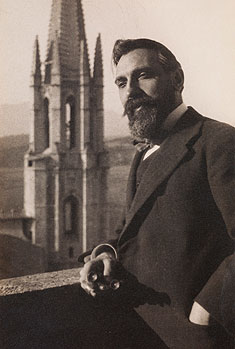Rafael Masó i Valentí facts for kids
Quick facts for kids
Rafael Masó i Valentí
|
|
|---|---|

Portrait of Rafael Maso with the church of Sant Feliu behind
|
|
| Born | 16 August 1880 |
| Died | 13 July1935 Girona, Catalonia, Spain
|
| Nationality | Spanish |
| Occupation | Architect |
| Buildings | Farinera Teixidor, Casa Batlle, Casa Salieti, Casa Masó |
| Projects | Ciutat-jardí de S’Agaró |
Rafael Masó i Valentí (born 1880, died 1935) was a very important architect from Catalonia, Spain, in the early 1900s. He was born in Girona, a city in Catalonia. His family was cultured and believed strongly in Catalan traditions and identity. This family background helped shape him into the architect he became. He loved Girona and its old customs.
Masó admired another famous architect, Antoni Gaudí. However, when Masó was a student in Barcelona, he joined a group of artists and writers. They started a new art movement called Noucentisme. This movement was an alternative to the earlier style called Modernisme. Noucentisme focused on civic spirit, Catalan identity, and modern, European ideas. These ideas inspired young Masó. He also became a talented poet, a city planner, a politician, and someone who helped promote art and literature.
Contents
Rafael Masó's Life and Buildings
Rafael Masó lived in the Masó House until 1912, when he married Esperança Bru. Most of his work was done in Girona and the areas nearby. He designed many different types of buildings. These included houses, villas, and apartment blocks. He also designed schools, hospitals, shops, and factories.
Masó was also involved in fixing up old farmhouses. He helped restore medieval buildings, which means making old, historic buildings look good again.
Famous Buildings by Rafael Masó
Some of his most well-known works are:
- The Teixidor Flour Mill (built in 1910) in Girona.
- The Masó House (built in 1911) in Girona.
- The Athenea cultural center (built in 1912) in Girona.
- The Masramon House (built in 1913) in Olot.
- The Casas House (built in 1914) in Sant Feliu de Guíxols.
- The S’Agaró garden city (started in 1923).
Sadly, some of Masó's building plans were never built. This happened because clients did not always agree with his ideas. Also, after he died, some of his buildings were torn down or changed so much they looked completely different.
Masó's Unique Style
Rafael Masó's work shows his connection to the Noucentisme ideas. He believed in a modern style that still kept the simple beauty of classicism. He used shapes, colors, and materials from the local culture. He also relied a lot on traditional craft techniques.
He was greatly influenced by the English Arts & Crafts movement. He also liked the new German regionalist architecture. Masó wanted to combine the old tradition of local buildings with new ideas. These new ideas were about how buildings were structured, how they were decorated, and how their insides were designed. He even designed furniture!
Masó played a big part in bringing modern ideas about homes to Catalonia. He helped update traditional crafts. He also worked to protect Catalonia's historic buildings and promote cultural activities.
Images for kids
See also

- In Spanish: Rafael Masó para niños














